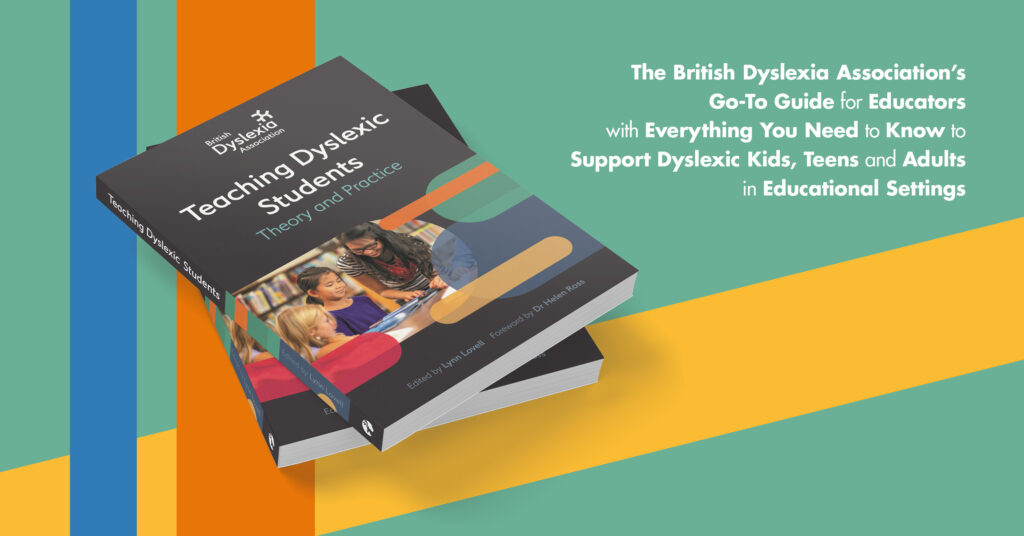By Lynn Lovell, Editor of Teaching Dyslexic Students by contributors from The British Dyslexia Association.

An estimated 10-15% of the population have dyslexia, so it is clear how vitally important it is for educators to know how to effectively support individuals with this specific difficulty. The good news is, there are core principles that we can apply when teaching individuals that are proven to be of benefit to those with dyslexia, and will be beneficial to all students. These are likely to already be inherent in everyday teaching but the examples below show how they can be used more explicitly in the teaching of literacy and numeracy. These are deemed to be the core principles of specialist teaching, although there are likely to be benefits to applying this more widely in classroom teaching.
The five key principles are:
Structured: This means that teaching takes place in a logical order of sequential steps. As an example, when teaching sounds we might start with the letters SATPIN as these make common sounds that can easily be used to build words like sit, sat, pin and so on. You could then move on to less common letters, as well as digraphs and trigraphs (groups of two or three letters that make one sound).
In the same way, if teaching an individual to add two-digit numbers, you would not do so without having taught them to add single numbers first.
Cumulative: Is where new learning builds on previous learning. In order to do so, we should revise what the individual already knows and then ‘stretch’ this a little further. As an example, if they know the sounds that the letters ‘s’ and ‘t’ make, can we then blend these together to make the sound ‘st’?
In the same way, if we want to teach adding fractions, then can we do so by revising the addition of single numbers before applying this to adding the numerators in a fraction?
Multisensory: The term multi-sensory is often misunderstood as using more than one sense when teaching. An important distinction to make is that it means using more than one sense at a time. An example would be, saying the names or sounds of letters when spelling words out as this helps to embed the spelling in memory as different areas of the brain are being used at the same time. In the same way, talking through a maths process as it is being carried out helps learners make connections and retain concepts.
Over-learning: This is where information is revisited, to make sure learning is secure and is transferred to long-term memory. For many learners, they may retain information in the short-term but find it harder to do so in the long-term. An example of this is when a learner gains 10/10 on a spelling test but then cannot do so the following week. Learners with dyslexia in particular may take many repetitions to be able to recall and apply what they have learnt. In the same way, times tables are often challenging to remember and re-visiting this over time and using different methods is likely to aid retention.
Metacognition: This is an individual’s own understanding of how they learn best, what they are good at, but also what is not so good when learning. For example, student A is very good at drawing but struggles with spelling. They are encouraged to make flashcards of words they struggle with where the tricky/notable letter patterns are in colour and an image is added to support memory. So, if they were trying to remember how to spell separate, they may want to highlight the ‘rat’ part and draw a picture of a rat on their flashcard. Student B however, is very good at music but struggles with times tables. He makes up a song/rap to help him remember the tables he is struggling with.
These approaches are beneficial for all learners, particularly those with dyslexia for a number of reasons. A structured and cumulative approached allows learners to link new learning to previous learning, which reduces the load on memory. Doing so in small, logical steps allows learning to be secured before moving on.
Memory can be a particular issue for those with dyslexia and it may take many repetitions before something is retained, thus over-learning is a valuable tool. Teaching in a multi-sensory way will help to embed information more easily, allowing connections to be made in the brain.
Finally, in understanding how they learn best. Individuals can apply those techniques in other situations to help ensure success. This can be particularly important where the individual may have areas of particular challenge, as those with dyslexia are likely to have. Not forgetting that we all also have many areas of strength which we can use to support learning.

Read more about the book, The British Dyslexia Association – Teaching Dyslexic Students